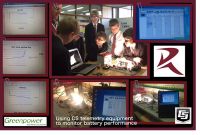Campbell Scientific In Action photo competition winners
Here are the winning images in our recent Campbell Scientific In Action photographic competition. Thank you to all that entered. We will be publishing a gallery of all entries shortly.
| Category | Image (click to enlarge) | Winner | Description |
| Overall Winner |  |
Professor Jason Box Geological Survey of Denmark and Greenland |
The attached photos are of a fixed wing UAV we flew successfully on missions over Greenland ice August 2014. On board was a CR200x data logger with up and down CS300 Campbell pyrometers measuring ice reflectivity, a.k.a “albedo". The work was joint between the Geological Survey of Denmark and Greenland (GEUS), The Dark Snow Project, and The University of Wales, Aberystwyth. The fellow in the photos is named Johnny Ryan. I appear in one photo with Johnny. Jason E. Box - professor GEUS – Geological Survey of Denmark and Greenland |
| Weather |  |
Jack Triest La Tronche, France |
The photo was taken at 'Refuge Vallot' just below the summit of the Mont Blanc at an altitude of 4362m in the summer of 2013. My colleague (pictured) and I work at 'Laboratoire de Glaciologie et Geophysique de l'Environment' and our team is specialised in ice core science. This weather station was placed on the Mont Blanc as it is one of the only places in Europe where ice cores with a significant climate record can still be drilled. Weather information can help us better interpret the ice core data. |
| Water |  |
Bouger Guillaume CNRS Ingeneer Assistant, Rennes, France |
We have installed a Campbell CR1000 on a raft. The purpose is to have a very locale standard and precise weather station. We also have a dual channel-pyranometer sensor to make precise measurement of the energy stored into the lake. The purpose is to understand the algae bloom in this place used for the city water. |
| Energy |  |
Professor Norbert Geuder CSP Services GmbH, Germany |
It was taken by myself in February 2013 after installation the automatic weather station at the Solar Furnace in Parkent, Uzbekistan, for my company CSP Services. Our weather stations use the Campbell Scientific CR1000 data logger with corresponding infrastructure like GPRS modem for remote connection, furthermore the CS215 temperature and humidity probe in its radiation shield and the CS120 Atmospheric Visibility Sensor for measuring solar beam irradiation and atmospheric attenuation. In total, six stations are distributed within this project over the country. Purpose of the measurement campaign is the site assessment in order to check the solar resource and thus the potential for building concentrating solar thermal power plants (CSP) in the country of Uzbekistan and finally contribute significantly to the energy supply of the country, moreover renewable and clean energy. We gladly use Campbell Scientific instruments as they are very robust in whatever weather conditions we find. The equipment behaves perfectly in the dry and hot summer as well during the chilling winter. |
| Machines |  |
Mrs Cox Head of Science & Senior STEM Leader Redmoor Academy, Hinckley, UK |
The collage is a collection of images showing Redmoor pupils using a Campbell CR200 to profile batteries used in the national Green Power Educational Trust Electric Car Engineering Challenge along with some of the graphs showing the logged data. |
| Structures |  |
Sean Hocking Accolade Measurements, UK |
It’s a photo of an install we did on Clympwick bridge a few months ago using inclinometers and LVDT’s to monitor the displacement of the bridge over time. In the install we also used some Campbell Sci products including the CR1000, AM16/32 and a COM110. We had to use an under-bridge unit due to the hard to reach nature of the bridge which made for a nice photo |
| Earth |  |
Dr Timothy Hill School of Geography and Geosciences. St Andrew's University, UK |
A cold, frosty day measuring fluxes over a tidally inundated saltmarsh in the UK with the CPEC200 eddy covariance system. |